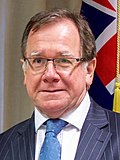National Emergency Management Agency (New Zealand)
 From Wikipedia - Reading time: 9 min
From Wikipedia - Reading time: 9 min
| Te Rākau Whakamarumaru (Māori) | |
 | |
| Agency overview | |
|---|---|
| Formed | 1 December 2019 |
| Preceding agency |
|
| Jurisdiction | New Zealand |
| Headquarters | TSB House, Wellington |
| Minister responsible |
|
| Agency executive |
|
| Parent agency | Department of the Prime Minister and Cabinet (New Zealand) |
| Child agency | |
| Website | civildefence |
The National Emergency Management Agency (NEMA; Māori: Te Rākau Whakamarumaru) is the public service department of New Zealand responsible for providing leadership and support around national, local and regional emergencies. It is an autonomous departmental agency hosted by the Department of Prime Minister and Cabinet. It replaced the Ministry of Civil Defence and Emergency Management in December 2019.
The Minister for Emergency Management is currently Mark Mitchell.[1]
History
[edit]No formal civil defence or emergency management structure existed in New Zealand until the 1930s, when the increasing threat of war prompted the formation of the Emergency Precautions Scheme, which was controlled by the Department of Internal Affairs.[2] In addition to war, earthquake risk was another concern of the Scheme, prompted in part by the 1931 Hawke's Bay earthquake. During World War II, the name of the EPS was changed to Civil Defence. While EPS/Civil Defence did not need to respond to any invasion attempts, it was twice called upon to assist with earthquake recovery efforts in Wellington and the Wairarapa region in 1942.
First Minister of Civil Defence
[edit]Following the war, responsibility for civil defence was assumed by the Department of Internal Affairs. A Review of Defence white paper, issued by the Second Labour Government amid the fear of nuclear war, proposed the establishment of a separate Ministry of Civil Defence. The first Director of Civil Defence was J.V. Meech (also the Secretary of Internal Affairs), though in practice much of the work was delegated to Andrew Sharp; the first Minister of Civil Defence in the post-war period was Bill Anderton (also the Minister of Internal Affairs). The Civil Defence Act 1962 set out in legislation the responsibilities and duties of the Ministry. In 1964, the first full-time Director of Civil Defence was appointed: Brigadier R.C. Queree.
A new Ministry for Emergency Management was established under the National/New Zealand First Coalition Government by Civil Defence Minister Jack Elder on 1 July 1999, following the Review of Emergency Services.[3][4][5] This replaced the existing Ministry of Civil Defence.[6] Later, the department name changed again to become the Ministry of Civil Defence & Emergency Management.
Transfer to Department of Prime Minister and Cabinet
[edit]The Ministry of Civil Defence & Emergency Management remained a business unit of the Department of Internal Affairs until 1 April 2014, when it was transferred to the Department of Prime Minister and Cabinet.[7] This was intended to reflect DMPC's role as the government's lead agency in national security planning.[8]
Beginning 1 December 2019, the Ministry's name was changed to the National Emergency Management Agency (NEMA). Its structure was also changed, with it becoming a departmental agency and the appointment of NEMA's first interim chief executive (rather than reporting through to the chief executive of DPMC). A departmental agency is an operationally autonomous agency with its own chief executive, hosted by a department of the New Zealand public service.
Inquiry following North Island severe weather events
[edit]In 2024, the Government released the findings of an inquiry into the performance of New Zealand's emergency management system. The inquiry focussed on the response to three severe weather events in the North Island in early 2023: Cyclone Hale (8 to 12 January), Auckland Anniversary floods (26 January to 3 February), and Cyclone Gabrielle (12 to 16 February). The three severe weather events caused 15 fatalities, and the estimated cost of damage was in the range $9 –14.5 billion. The inquiry report concluded that:[9]
Many communities and CDEM (Civil Defence Emergency Management) agencies were not adequately prepared, communication and warnings were non-existent or insufficient, and the capability and capacity of people and infrastructure was overestimated or lacking.
The National Emergency Management Agency conducted its own internal review and concluded that it lacked sufficient well-trained personnel and leadership to deal with the severe weather events. It also found that the facilities used by the National Crisis Management Centre and the National Co-ordination Centre were not fit for purpose and that technology used by these centres was not reliable.[10]
Activities
[edit]The Agency administers the Civil Defence Emergency Management Act 2002 and:[11]
- advises government on matters relating to civil defence emergency management
- identifies hazards and risks
- develops, maintains and evaluates the strategy for civil defence emergency management
- ensures coordination at national, regional and local levels
- promotes civil defence emergency management and deliver public awareness about how to prepare for, and what to do in, an emergency
- supports planning, operations and capability development for the civil defence emergency management sector,and develops standards and guidelines
- monitors and evaluates the performance of Civil Defence Emergency Management groups in 16 regions
- maintains and operates the National Crisis Management Centre, including providing personnel to staff the Centre
- issues public information and warnings
- manages the response of central government to major emergencies (such as earthquake, tsunami, landslide, volcanic eruptions or unrest, floods, severe winds, snow, coastal hazards, and failure of critical infrastructure)
Since 2017, Civil Defence has utilised Emergency Mobile Alert technologies to deliver essential emergency information to mobile phones in New Zealand. They test it every year to make sure the system is working correctly.[12] During the 2017 Mobile Alert test, Vodafone accidentally sent the test alert message at 1 AM.[13]
List of ministers for emergency management
[edit]- Key
National Labour NZ First Mauri Pacific
| No. | Name | Portrait | Term of office | Prime Minister | |||
|---|---|---|---|---|---|---|---|
| 1 | William Bodkin | 
|
30 June 1942 | 2 October 1942 | Fraser (in the War Administration) | ||
| 2 | David Wilson | 
|
30 October 1942 | 12 April 1944 | Fraser | ||
| 1944–1959: See Minister of Internal Affairs | |||||||
| 3 | Bill Anderton | 
|
24 June 1959 | 12 December 1960 | Nash | ||
| 4 | Leon Götz | 
|
12 December 1960 | 20 December 1963 | Holyoake | ||
| 5 | David Seath | 
|
20 December 1963 | 9 February 1972 | |||
| 6 | Allan Highet | 
|
9 February 1972 | 8 December 1972 | Marshall | ||
| 7 | Tom McGuigan | 
|
8 December 1972 | 10 September 1974 | Kirk | ||
| 8 | Henry May | 
|
10 September 1974 | 12 December 1975 | Rowling | ||
| (6) | Allan Highet | 
|
12 December 1975 | 26 July 1984 | Muldoon | ||
| 9 | Peter Tapsell | 
|
26 July 1984 | 24 July 1987 | Lange | ||
| 10 | Michael Bassett | 
|
24 July 1987 | 9 February 1990 | |||
| Palmer | |||||||
| 11 | Margaret Austin | 
|
9 February 1990 | 2 November 1990 | |||
| Moore | |||||||
| 12 | Graeme Lee | 
|
2 November 1990 | 29 November 1993 | Bolger | ||
| 13 | Warren Cooper | 
|
29 November 1993 | 1 March 1996 | |||
| 14 | John Banks | 
|
1 March 1996 | 1 November 1996 | |||
| 15 | Murray McCully | 
|
1 November 1996 | 16 December 1996 | |||
| 16 | Jack Elder | 
|
16 December 1996 | 10 December 1999 | |||
| Shipley | |||||||
| 17 | George Hawkins | 
|
16 December 1999 | 19 October 2005 | Clark | ||
| 18 | Rick Barker | 
|
19 October 2005 | 19 November 2008 | |||
| 19 | John Carter | 
|
19 November 2008 | 8 June 2011 | Key | ||
| 20 | Craig Foss | 8 June 2011 | 14 December 2011 | ||||
| 21 | Chris Tremain | 
|
14 December 2011 | 30 January 2013 | |||
| 22 | Nikki Kaye | 
|
30 January 2013 | 20 December 2016 | |||
| English | |||||||
| 23 | Gerry Brownlee | 
|
20 December 2016 | 2 May 2017 | |||
| 24 | Nathan Guy | 
|
2 May 2017 | 26 October 2017 | |||
| 25 | Kris Faafoi | 
|
26 October 2017 | 27 June 2019 | Ardern | ||
| 26 | Peeni Henare | 
|
27 June 2019 | 6 November 2020 | |||
| 27 | Kiri Allan | 
|
6 November 2020 | 14 June 2022 | |||
| 28 | Kieran McAnulty | 
|
14 June 2022 | 27 November 2023 | |||
| Hipkins | |||||||
| 29 | Mark Mitchell | 
|
27 November 2023 | present | Luxon | ||
See also
[edit]References
[edit]- ^ "Ministerial List". Department of the Prime Minister and Cabinet. Retrieved 27 November 2023.
- ^ Ministry of Civil Defence & Emergency Management (1990). "Civil Defence in New Zealand: A Short History" (PDF). Archived from the original (PDF) on 11 August 2017.
- ^ Shirley Mattingly (2007). "Policy, Legal and Institutional Arrangements" (PDF). Retrieved 19 September 2017.
- ^ Jack Elder (5 August 1999). "New moves to protect communities". Retrieved 19 September 2017.
- ^ "Vote Emergency Management" (PDF). 2003. p. 516. Retrieved 19 September 2017.
- ^ "Valedictory statement of Hon Jack Elder". 7 October 1999. Retrieved 19 September 2017.
- ^ Nikki Kaye (31 March 2014). "Civil defence moves to Department of Prime Minister and Cabinet". Beehive.govt.nz. Retrieved 19 September 2017.
- ^ Jonathan Coleman; Nikki Kaye (19 November 2013). "MCDEM shift will strengthen emergency management and resilience". Retrieved 19 September 2017.
- ^ Crimp, Lauren (23 April 2024). "'Significant shortcomings' in NZ's emergency management system - inquiry". RNZ. Retrieved 8 August 2024.
- ^ Plummer, Benjamin (16 May 2024). "National Emergency Management Agency review highlights lack of well-trained staff to deal with severe weather events". The New Zealand Herald. Retrieved 8 August 2024.
- ^ "About the Ministry". Ministry of Civil Defence and Emergency Management. Archived from the original on 15 June 2017. Retrieved 19 September 2017.
- ^ "Emergency Mobile Alert". www.civildefence.govt.nz. Retrieved 25 November 2019.
- ^ "Good morning! It's your 1.32am Civil Defence alert test". 3 October 2017. ISSN 1170-0777. Retrieved 25 November 2019.
 KSF
KSF